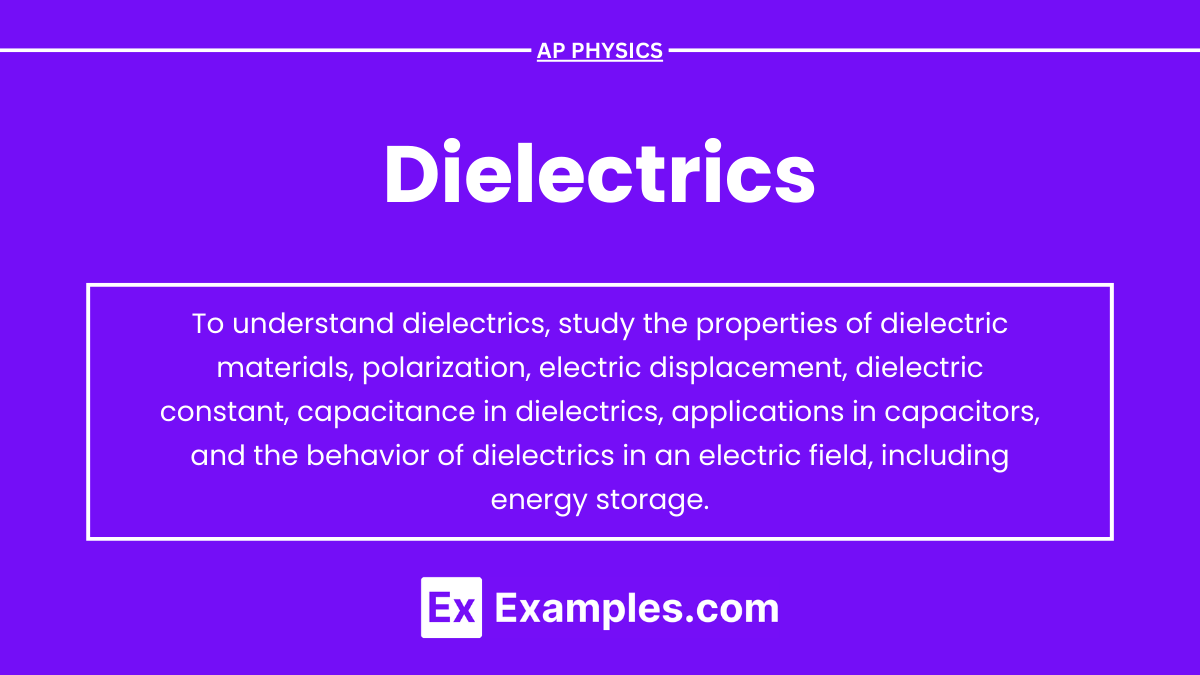Dielectrics are insulating materials that, when placed in an electric field, become polarized, reducing the field’s strength within the material. This property is essential in applications like capacitors, where dielectrics enhance the ability to store electrical energy. In the context of AP Physics, understanding dielectrics is crucial for mastering topics related to electrostatics, capacitance, and electric fields. Their role in increasing capacitance and influencing electric field behavior makes them a key concept in the AP Physics curriculum.
Learning Objectives
For the AP Physics exam, you should focus on understanding how dielectrics affect electric fields and capacitance. Learn the concept of dielectric polarization, how to calculate the capacitance of a capacitor with a dielectric, and the role of the dielectric constant. Understand the significance of electric displacement fields and dielectric breakdown. Practice applying these concepts to solve problems involving capacitors and electric fields in dielectrics, ensuring you can analyze and predict their behavior in various scenarios.
What is a Dielectric?
A dielectric is a material that does not conduct electricity but can support an electric field. In other words, it is an insulating material that becomes polarized when exposed to an electric field. Common dielectric materials include glass, plastic, rubber, and ceramics.
Dielectric Polarization
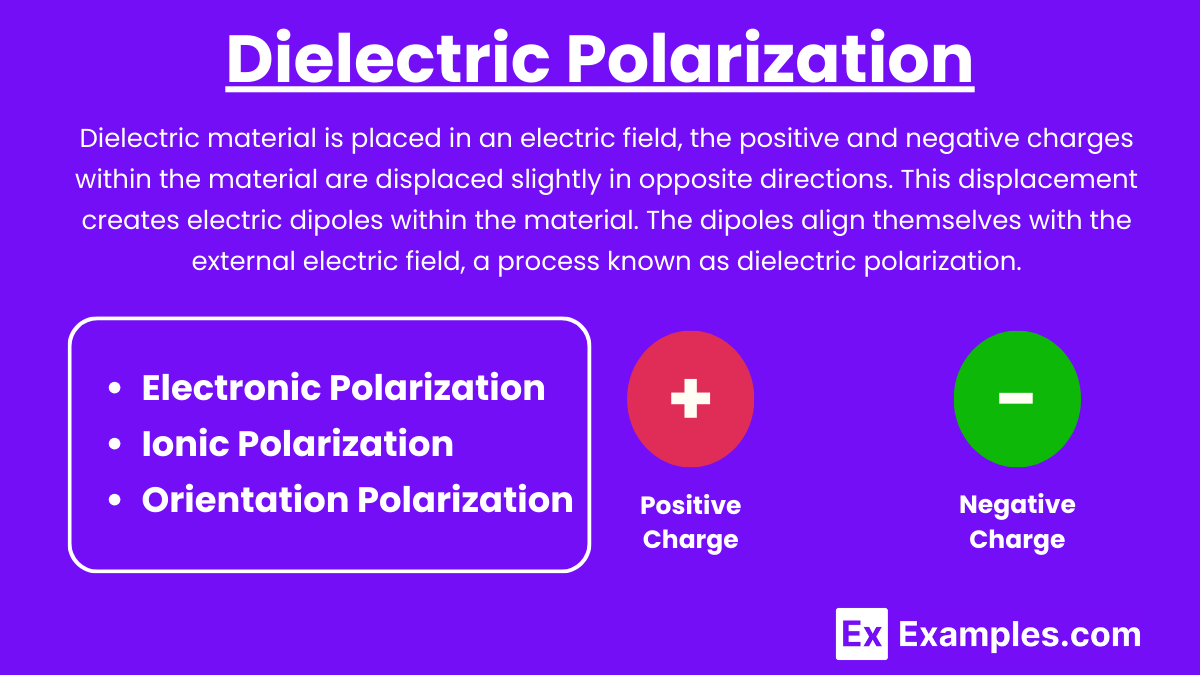
When a dielectric material is placed in an electric field, the positive and negative charges within the material are displaced slightly in opposite directions. This displacement creates electric dipoles within the material. The dipoles align themselves with the external electric field, a process known as dielectric polarization.
Types of Polarization
- Electronic Polarization: Occurs when the electron cloud around an atom or molecule is displaced relative to the nucleus.
- Ionic Polarization: Happens in ionic materials where positive and negative ions are displaced relative to each other.
- Orientation Polarization: Occurs in materials with permanent dipoles, like water, where the dipoles rotate to align with the electric field.
Dielectric Constant (Relative Permittivity)
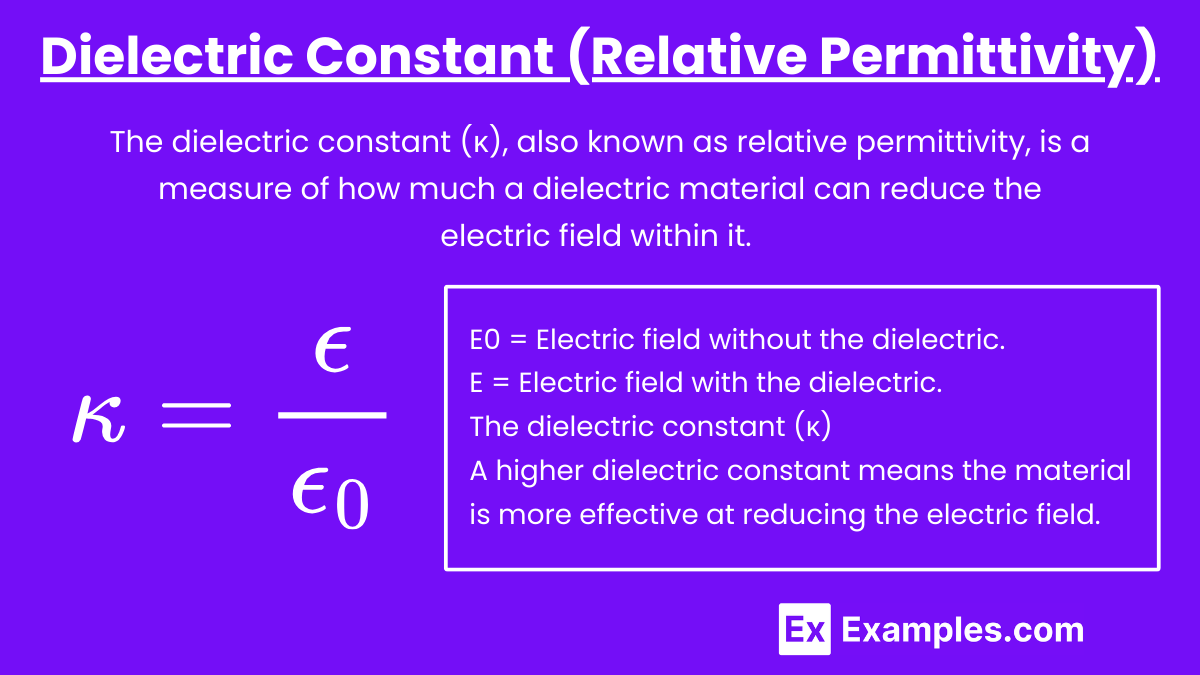
The dielectric constant (κ), also known as relative permittivity, is a measure of how much a dielectric material can reduce the electric field within it. It is defined as the ratio of the permittivity of the dielectric material (ε) to the permittivity of free space
Where :
E0 = Electric field without the dielectric.
E = Electric field with the dielectric.
A higher dielectric constant means the material is more effective at reducing the electric field.
Dielectrics in Capacitors
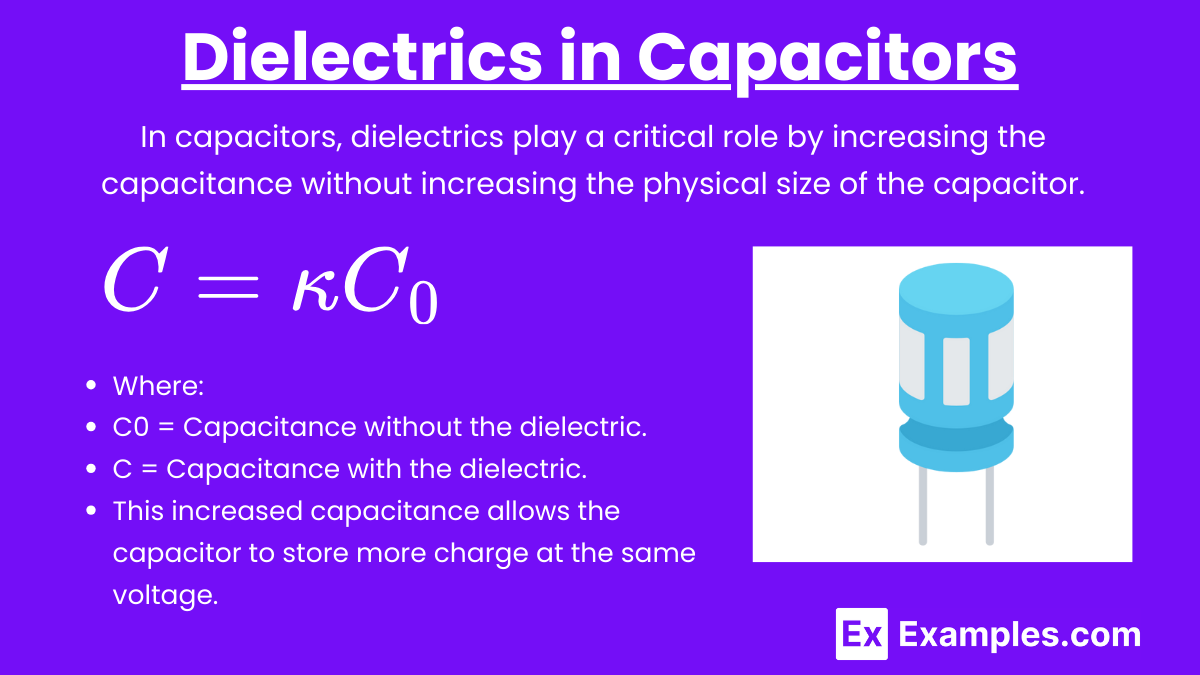
In capacitors, dielectrics play a critical role by increasing the capacitance without increasing the physical size of the capacitor. When a dielectric is placed between the plates of a capacitor:
- Capacitance Increases: The capacitance C of a capacitor with a dielectric is given by:
where
C0 = Capacitance without the dielectric.
C = Capacitance with the dielectric.
This increased capacitance allows the capacitor to store more charge at the same voltage.
- Voltage Decreases: For a given charge, the voltage across the capacitor decreases when a dielectric is introduced.
- Energy Storage: The energy stored in a capacitor is given by:
Since the capacitance increases, the energy storage capacity also increases with a dielectric.
Dielectric Breakdown
Dielectric materials have a limit to how much electric field they can withstand before they become conductive. This limit is called the dielectric strength. When the electric field exceeds this threshold, the dielectric material undergoes dielectric breakdown and allows current to pass through, potentially damaging the material and the circuit.
Applications of Dielectrics
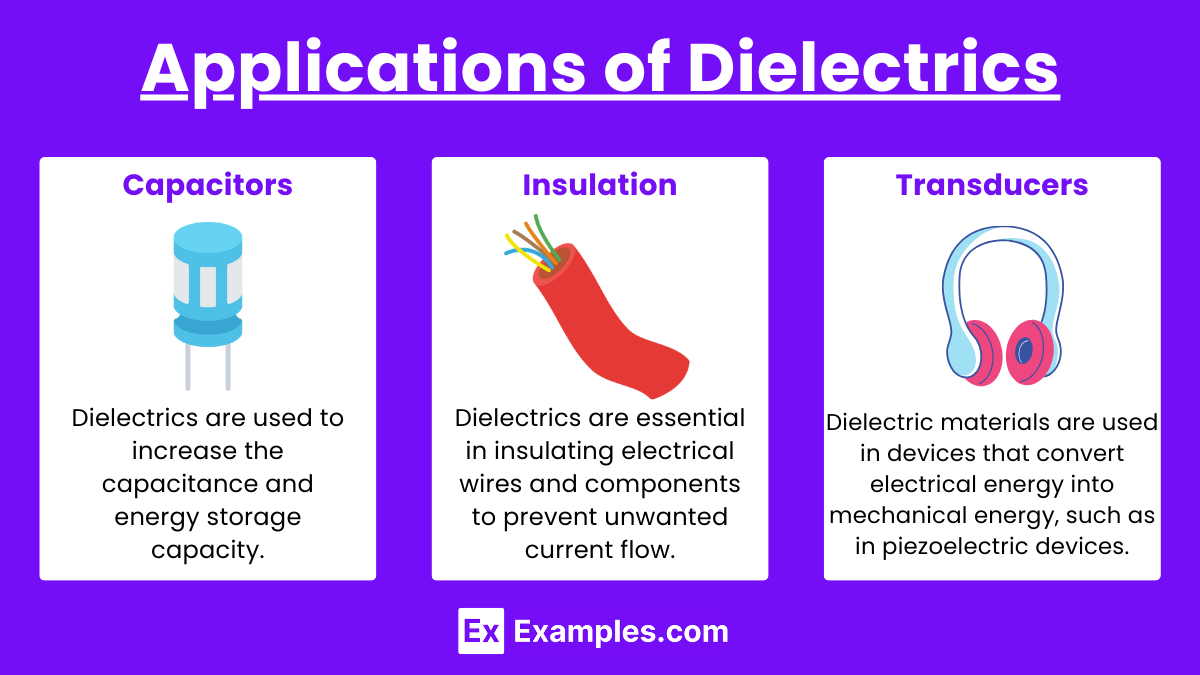
- Capacitors: Dielectrics are used to increase the capacitance and energy storage capacity.
- Insulation: Dielectrics are essential in insulating electrical wires and components to prevent unwanted current flow.
- Transducers: Dielectric materials are used in devices that convert electrical energy into mechanical energy, such as in piezoelectric devices.
Key Equations Involving Dielectrics
- Capacitance with Dielectric:
where:
- C is the capacitance,
- κ is the dielectric constant,
- A is the area of the plates,
- d is the separation between the plates.
- Electric Field in a Dielectric:
where:
- E is the reduced electric field inside the dielectric,
- E0 is the electric field without the dielectric.
- Energy Stored in a Capacitor:
Understanding dielectrics is crucial for mastering concepts in electrostatics, especially for the AP Physics exam. Dielectrics not only increase capacitance but also have wide applications in everyday electrical and electronic devices. Focus on mastering the relationship between the dielectric constant, capacitance, and electric field to excel in problems involving dielectrics.
Examples
Example 1: Glass
Glass is a widely used dielectric material in capacitors and insulating applications. It has a high dielectric strength and is resistant to moisture, making it ideal for use in harsh environments. Its transparency also makes it useful in optical applications.
Example 2: Porcelain
Porcelain, a type of ceramic, is commonly used in high-voltage applications such as insulators on power lines and in electrical switches. It has excellent thermal and mechanical stability, along with a high dielectric constant, which makes it perfect for handling large voltages without breaking down.
Example 3: Mica
Mica is a naturally occurring mineral with exceptional dielectric properties. It is often used in capacitors and as insulation in high-temperature environments. Mica sheets are thin, flexible, and can withstand high voltages, making them valuable in electrical and electronic industries.
Example 4: Teflon
Teflon (polytetrafluoroethylene or PTFE) is a synthetic polymer with a very low dielectric constant and high resistance to chemical reactions. It is commonly used in cables, wire insulation, and circuit boards due to its non-reactive nature and ability to insulate against high frequencies.
Example 5: Paper
Paper, especially when impregnated with oil or wax, serves as an excellent dielectric material in transformers, capacitors, and cables. It is cost-effective, easy to produce, and has a decent dielectric constant, making it suitable for a variety of low to medium voltage applications.
Multiple Choice Questions
Question 1
A dielectric material is placed between the plates of a parallel plate capacitor. What effect does this have on the capacitance of the capacitor?
A) The capacitance decreases
B) The capacitance remains unchanged
C) The capacitance increases
D) The dielectric material gets polarized but the capacitance remains the same
Answer: C) The capacitance increases
Explanation:
When a dielectric material is inserted between the plates of a capacitor, the capacitance increases. This happens because the dielectric reduces the electric field between the plates for the same amount of charge, thereby allowing the capacitor to store more charge for a given voltage. The capacitance C with a dielectric is given by the equation:
where κ (the dielectric constant) is greater than 1, and C0 is the capacitance without the dielectric. Therefore, the capacitance increases.
Question 2
Which of the following is a characteristic of a dielectric material when placed in an electric field?
A) It conducts electricity
B) It becomes a perfect insulator
C) It gets polarized
D) It produces a magnetic field
Answer: C) It gets polarized
Explanation:
Dielectric materials are insulators, meaning they do not conduct electricity. However, when placed in an electric field, the molecules within the dielectric align themselves in such a way that their positive and negative charges are displaced in opposite directions. This alignment creates an induced electric field that opposes the external electric field, a process known as polarization. This polarization is the defining characteristic of a dielectric material in an electric field.
Question 3
Which of the following best describes the energy stored in a capacitor when a dielectric is introduced between its plates?
A) The energy stored decreases because the voltage decreases
B) The energy stored remains unchanged
C) The energy stored increases because the capacitance increases
D) The energy stored depends solely on the battery’s voltage
Answer: C) The energy stored increases because the capacitance increases
Explanation:
The energy stored in a capacitor is given by the equation:
where U is the stored energy, C is the capacitance, and V is the voltage. When a dielectric is introduced, the capacitance C increases (as discussed in Question 1). Assuming the voltage V provided by the battery remains constant, the energy stored in the capacitor increases because the energy is directly proportional to the capacitance.

